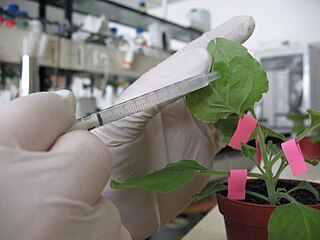Bacterial conjugation is the transfer of genetic material between bacterial cells by direct cell-to-cell contact or by a bridge-like connection between two cells. This takes place through a pilus.

In molecular biology, transformation is the genetic alteration of a cell resulting from the direct uptake and incorporation of exogenous genetic material from its surroundings through the cell membrane(s). For transformation to take place, the recipient bacteria must be in a state of competence, which might occur in nature as a time-limited response to environmental conditions such as starvation and cell density, and may also be induced in a laboratory.

The transfer DNA is the transferred DNA of the tumor-inducing (Ti) plasmid of some species of bacteria such as Agrobacterium tumefaciens and Agrobacterium rhizogenes(actually an Ri plasmid). The T-DNA is transferred from bacterium into the host plant's nuclear DNA genome. The capability of this specialized tumor-inducing (Ti) plasmid is attributed to two essential regions required for DNA transfer to the host cell. As the T-DNA is bordered by 25-base-pair repeats on each end. Transfer is initiated at the right border and terminated at the left border and requires the vir genes of the Ti plasmid.

The Rhizobiaceae is a family of proteobacteria comprising multiple subgroups that enhance and hinder plant development. Some bacteria found in the family are used for plant nutrition and collectively make up the rhizobia. Other bacteria such as Agrobacterium tumefaciens and A. rhizogenes severely alter the development of plants in their ability to induce crown galls or hairy roots found on the stem. The family has been of an interest to scientists for centuries in their ability to associate with plants and modify plant development. The Rhizobiaceae are, like all Proteobacteria, Gram-negative. They are aerobic, and the cells are usually rod-shaped. Many species of the Rhizobiaceae are diazotrophs which are able to fix nitrogen and are symbiotic with plant roots.

Mary-Dell Chilton is one of the founders of modern plant biotechnology.

Ferulic acid is a hydroxycinnamic acid, an organic compound. It is an abundant phenolic phytochemical found in plant cell walls, covalently bonded as side chains to molecules such as arabinoxylans. As a component of lignin, ferulic acid is a precursor in the manufacture of other aromatic compounds. The name is derived from the genus Ferula, referring to the giant fennel.
Rhizobium rhizogenes is a Gram-negative soil bacterium that produces hairy root disease in dicotyledonous plants. R. rhizogenes induces the formation of proliferative multiple-branched adventitious roots at the site of infection, so-called 'hairy roots'.
Gene delivery is the process of introducing foreign genetic material, such as DNA or RNA, into host cells. Genetic material must reach the nucleus of the host cell to induce gene expression. Successful gene delivery requires the foreign genetic material to remain stable within the host cell and can either integrate into the genome or replicate independently of it. This requires foreign DNA to be synthesized as part of a vector, which is designed to enter the desired host cell and deliver the transgene to that cell's genome. Vectors utilized as the method for gene delivery can be divided into two categories, recombinant viruses and synthetic vectors.

Agroinfiltration is a method used in plant biology and especially lately in plant biotechnology to induce transient expression of genes in a plant, or isolated leaves from a plant, or even in cultures of plant cells, in order to produce a desired protein. In the method a suspension of Agrobacterium tumefaciens is introduced into a plant leaf by direct injection or by vacuum infiltration, or brought into association with plant cells immobilised on a porous support, whereafter the bacteria transfer the desired gene into the plant cells via transfer of T-DNA. The main benefit of agroinfiltration when compared to the more traditional plant transformation is speed and convenience, although yields of the recombinant protein are generally also higher and more consistent.
Opines are low molecular weight compounds found in plant crown gall tumors or hairy root tumors produced by pathogenic bacteria of the genus Agrobacterium and Rhizobium. Opine biosynthesis is catalyzed by specific enzymes encoded by genes contained in a small segment of DNA, which is part of the Ti plasmid or Ri plasmid, inserted by the bacterium into the plant genome. The opines are used by the bacterium as an important energy, carbon and nitrogen source. Each strain of Agrobacterium and Rhizobium induces and catabolizes a specific set of opines, this set typifying the Ti plasmid and Ri plasmid. There are some 30 different opines described so far.

Jozef Stefaan "Jeff", Baron Schell was a Belgian molecular biologist.
Plant transformation vectors are plasmids that have been specifically designed to facilitate the generation of transgenic plants. The most commonly used plant transformation vectors are termed binary vectors because of their ability to replicate in both E. coli, a common lab bacterium, and Agrobacterium tumefaciens, a bacterium used to insert the recombinant (customized) DNA into plants. Plant Transformation vectors contain three key elements;
A transfer DNA (T-DNA) binary system is a pair of plasmids consisting of a binary plasmid and a helper plasmid. The two plasmids are used together to produce genetically modified plants. They are artificial vectors that have both been created from the naturally occurring Ti plasmid found in Agrobacterium tumefaciens. The binary vector is a shuttle vector, so-called because it is able to replicate in multiple hosts.

Acetosyringone is a phenolic natural product, and is a chemical compound related to acetophenone and 2,6-dimethoxyphenol. It was first described in relation to lignan/phenylpropanoid-type phytochemicals, with isolation from a variety of plant sources, in particular, in relation to wounding and other physiologic changes.

In biochemistry, naturally occurring phenols refers to phenol functional group that is found in natural products. Phenolic compounds are produced by plants and microorganisms. Organisms sometimes synthesize phenolic compounds in response to ecological pressures such as pathogen and insect attack, UV radiation and wounding. As they are present in food consumed in human diets and in plants used in traditional medicine of several cultures, their role in human health and disease is a subject of research. Some phenols are germicidal and are used in formulating disinfectants.
EHA101 was one of the first and most widely used Agrobacterium helper plasmid for plant gene transfer. Created in 1985 in the laboratory of Mary-Dell Chilton at Washington University in St. Louis, it was named after the graduate student who constructed it. The EH stands for "Elizabeth Hood" and A for "Agrobacterium". The EHA101 helper strain is a derivative of A281, the hypervirulent A. tumefaciens strain that causes large, fast-growing tumors on solanaceous plants. This strain is used for moving genes of interest into many hundreds of species of plants all over the world.
Allorhizobium vitis is a plant pathogen that infects grapevines. The species is best known for causing a tumor known as crown gall disease. One of the virulent strains, A. vitis S4, is responsible both for crown gall on grapevines and for inducing a hypersensitive response in other plant species. Grapevines that have been affected by crown gall disease produce fewer grapes than unaffected plants. Though not all strains of A. vitis are tumorigenic, most strains can damage plant hosts.









